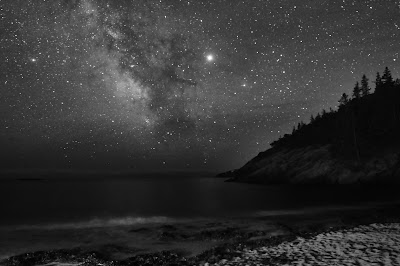 |
| Milky Way Panorama - Utah USA, Arches National Park Astrophotography |
This is panorama of 40 images which were done during my trip to Arches National Park. I really like this trip, and I believe that Arches National Park is one of the best place for landscape astrophotography. It is paradise for astrophotography – really dark sky (during new moon) and fantastic landscaping.
 |
| Milky Way Panorama - Maine USA, Acadia National Park Astrophotography |
 |
| Milky Way Panorama - Galapagos Astrophotography |
Not so much were changes on Galapagos Islands during last 3 millions years!
The marine iguana (Amblyrhynchus cristatus), also known as the sea iguana, saltwater iguana, or Galapagos marine iguana, is a species of iguana found only on the Galápagos Islands (Ecuador) that has the ability, unique among modern lizards, to forage in the sea, making it a marine reptile.
 |
| Panorama - Milky Way Shadow - Chile Astrophotography |
Milky Way casting shadows – for all my live don’t see many times. Need very dark sky, no moon, no light pollution. Also, when doing the photo of Milky Way panorama, I usually add extra light to see landscape. This was exception. Very dark sky – Chile Atacama Desert has one of the best skies for observation. On the astronomical tour had one request – no light. Location is desert oasis with trees. Scorpius and Sagittarius and Jupiter are close to zenith. As result on the photo you can see diffuse shadows from trees casing by Milky Way. Really, there is the place where the Milky Way casts a shadow!
 |
| First Canon Ra Milky Way Rainbow - Catskill NY |
This is my first photo of Milky Way Rainbow with Canon EOS Ra. I am continue testing Canon Ra astrophotography camera. Canon Ra has High ISO performance with reasonable low noise levels (Topaz DeNoise AI allow minimize noise level). So even 5 sec photos with ISO 20,000 gives very nice result for night landscaping. Because of 5 sec shots – photo time is pretty fast. Special filter gives good contrast for Milky Way. Photoshop allows combine all 20 photos to one Milky Way rainbow panorama.
 |
| Milky Way and Zodiacal Light over Bolivia - Black and White Astrophotography |
The photo captures a view of the night sky over the Bolivia. 2 hours after sunset (elevation: 4020 m / 13190 feet). Canon EOS 60Da, 25 sec., Canon Lens EF16-35mm, f/2.8, ISO 6400, panorama of 20 images.
Because our eyes are less sensitive to color in low light conditions, a black and white photo more closely approximates what our eyes can see at night (compared to a color photo).
The black and white photography highlights the stark contrast between the dark night sky and the glowing band of the Milky Way. The Milky Way, a dense band of stars and interstellar dust, stretches across the sky in a white arc.
If you look closely, you can also see a faint, diffuse glow stretching up from the horizon. This is the Zodiacal Light, a ghostly band of light caused by sunlight reflecting off interplanetary dust particles in our solar system.
Taken together, the Milky Way and Zodiacal Light create a breathtaking scene that reminds us of the immense scale and beauty of the universe we inhabit. It is a testament to the power of nature and the wonders that can be discovered by simply looking up at the night sky.
The photo of the Milky Way and Zodiacal Light is an example of the beauty that can be found in the natural world. It is a reminder that there is always more to discover and explore, both here on Earth and beyond.






































